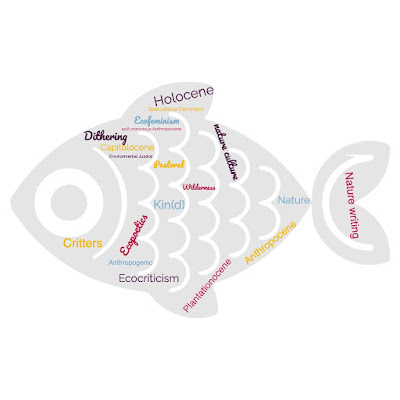Reading prompts for November 23
Choose either (or both),
1. "Languages of description may need to change under pressure of new angles of inquiry into how complex interrelationships make sense. (And vice versa as well.)" Comment on this sentence of "What is Experimental Poetry & Why do We Need It?" by Joan Retallack, in light of either Claudia Rankine's or Evelyn Reilly's poems
1. Listen to the beginning of this video where Evelyn Reilly reads from Styrofoam. In what ways does Evelyn Reilly's online performance - or, aleternatively, Claudia Rankine's "situation videos" (see previous post) - help you understand these poems better?




The poem Styrofoam written out presents itself as complicated and scientific based. I believe I was curious to see it read aloud by the poet because as we’ve experienced in class this semester, the delivery of the poem, including the age, tone and emphasis on words changes the experience of the meaning and weight of the poem. As we saw a couple classes ago when professor played us the child reading a poem instead of an adult or when Kwame read to us his own voice, we as an audience are able to experience different aspects than when just reading it through our mind, often silently. I suspected that Styrofoam would be a tad theatrical in its delivery, possibly even sort of a slam poet delivery of sorts, so I was surprised with the delivery of Evelyn Reilly, it’s a bit matter of fact. This makes sense though, as the poem is heavily scientific, and the importance of what she is saying doesn’t need to be theatrically stated. With Evelyn reading them the importance stays on the words, and what she is saying, not how she’s saying it. Honestly, the facts and the content is heavy enough. Humans have successfully created things that aren’t biodegradable and the consumer demand is such a beast that we, in the first world, have created a situation of landfills full of plastics, materials and styrofoam which isn’t biodegrading, and the pollution is harmful to all life forms, human, animal and environment. I don’t suppose her reading it helped understand this better, it just drove a further nail in our coffin, and the hope seems to dim a bit. It's reinforcing that we’ve created something that’s devastating and quite tragic. I suppose that Joan Retallack’s sentence correlates with Reilly’s poem as Reilly’s poetic approach is different; she hasn’t chosen artsy, whimsical words. I’m unaware of how many other poets have used chemicals, chemical levels and product testimonials in their poetry but I’m guessing it’s only a few. This alternative approach could be necessary to get people thinking differently about not only pollution, but also on language around how we discuss the environment and the arts. So, I think that Reilly is one example of Retallack’s statement and shifting the language between humans, chemicals, the environment and the array of issues we are currently facing because of these interwoven relationships.
ReplyDeleteCommenting on the sentence from Joan Retallack's essay, which I found very interesting, I can connect it to Reilly’s writing as well as Chabitnoy’s. In “Hence Mystical Cosmetic Over Sunset Landfill”, we can find an amalgamation of different pieces of information, scientific data, chemical compositions, actions, thoughts, wordplay, definitions, dialogue…Diverse styles of text, united in an unexpected manner. There is a kind of discontinuity, a certain lack of fluidity in the text. The reader can feel lost or surprised at times, great attention must be paid to the dispersed beads which form the necklace of the poem. There is connection but not in a traditional way, since the connection is not found through traditional continuity of language. This seems to follow the points made by Retallack regarding experimentation: “1. descriptive discontinuity; 2. resignation of our usual demands for visualization and causality; 3. renunciation of all attempts to obtain a detailed description of the individual transition processes.” Connectors are often not employed, and the expected obvious logical link between images or ideas is not quite present. There is experimentation in terms of form, prosody, grammar, syntax. This can be even jarring at times. Something I found interesting was the use of writing resembling that of website name perhaps (“that which fallsoutside.thespectrum”, “antarctic fowl.cherubim”). In the poem “She is making rope” there are similar techniques employed. Going back to the sentence from Retallack’s essay I think that poets, such as Retallack and Chabitnoy, try to use language in new ways, with new or unexpected constructions because they try to encompass many visions. When reading these poems (and others which take similar approaches) I frequently feel as though I am listening to an abundance of voices, sometimes with different tones and accents. There is a plurality, a choir of voices. The fact that the reader or listener has to try and catch up or adapt to these changes makes for an interesting effect. It makes one more aware of the “other”, of the reality that there exist other modes of perception and thinking outside of oneself. In spite of the discrepancy between these entities, species or voices, they are akin, they are linked. This is perhaps one way to manifest in writing “the chaotic interconnectedness of all things”, as Retallack wrote. If language is our intellectual tool then experimenting with it should entail an analogous experimenting in our thinking. As such, poetic experimentation could be a key to finding new (needed) narratives, new ways of seeing what is already there (“to acknowledge “them” as inextricably intertwined with us”).
ReplyDelete